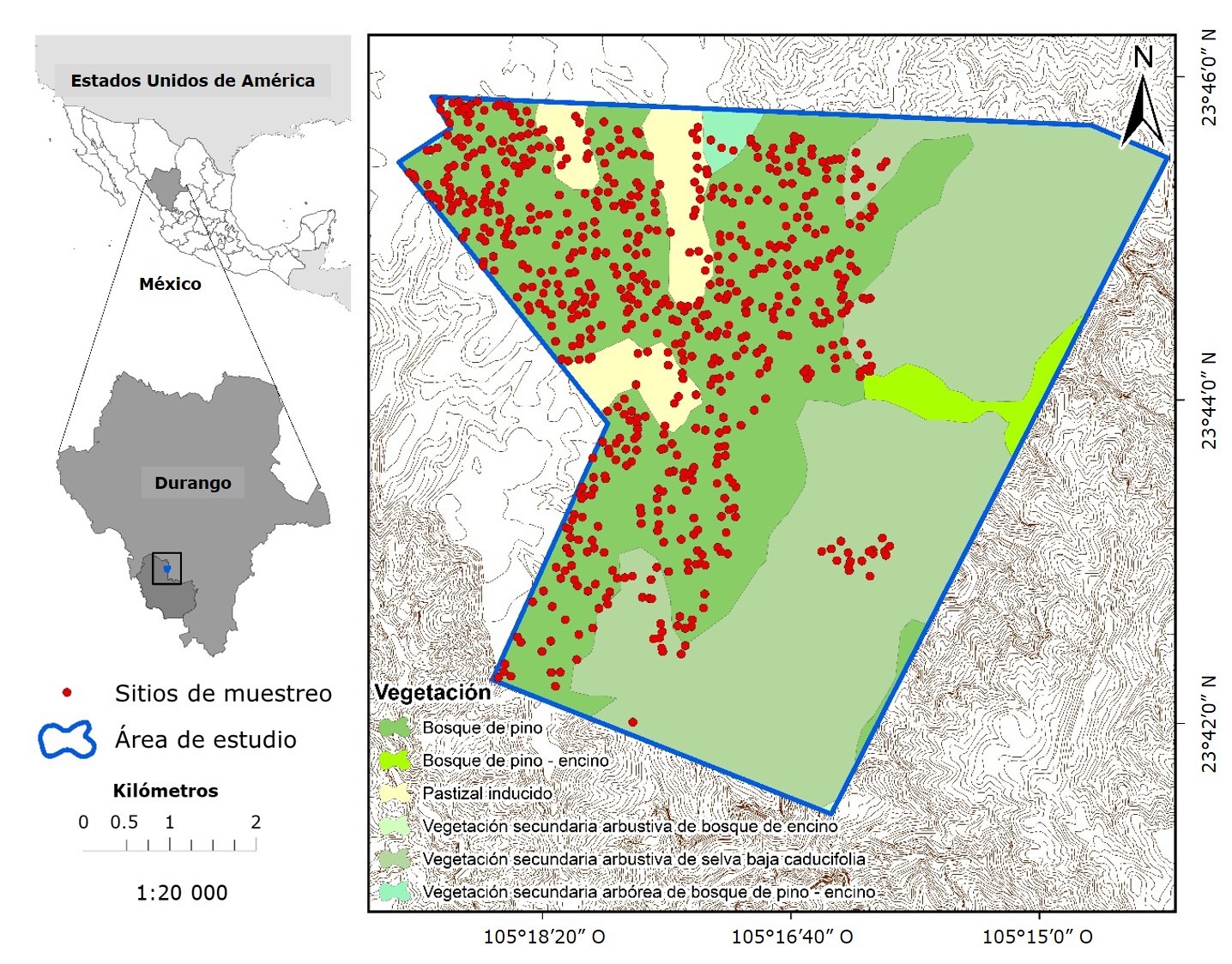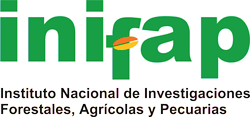Relationship of climate and remote sensing data with tree diversity in a temperate forest
DOI:
https://doi.org/10.29298/rmcf.v15i85.1477Keywords:
Temperate forests, spatial distribution, vegetation indices, forest management, local regression, species richnessAbstract
Quantifying biodiversity is key to natural resource conservation; however, data collection can be time-consuming and costly. Given that climate and remote sensing data help in the prediction of species diversity, the objective of this study was to analyze the relationship of climate data and the Normalized Difference Vegetation Index (NDVI) with tree diversity in a temperate forest in Northern Mexico. Species richness (S), Simpson's (1-D) and Shannon's (H) diversity indices were calculated at 663 sampling sites. Subsequently, an exploratory regression analysis was performed to obtain regression models that would account for the relationship of tree diversity indices with the NDVI, climatic data, and the number of trees. The best model for each diversity index and its predictor variables was integrated into a Geographically Weighted Regression (GWR) model. The results showed that the relationship of diversity indices and predictor variables varies across the space. The variables showed greater predictive potential in the Northern and Northwestern part of the study area. The NDVI was the variable with the greatest relative influence in the explanation of the diversity indices; therefore, it can function as a proxy for factors associated with tree diversity.
Downloads
References
Aceves-Rangel, L. D., J. Méndez-González, M. A. García-Aranda and J. A. Nájera-Luna. 2018. Potential distribution of 20 pine species in Mexico. Agrociencia 52:1043-1057. https://www.scielo.org.mx/pdf/agro/v52n7/2521-9766-agro-52-07-1043.pdf. (10 de agosto de 2024).
Amatulli, G., S. Domisch, M.-N. Tuanmu, B. Parmentier, … and W. Jetz. 2018. Data descriptor: A suite of global, cross-scale topographic variables for environmental and biodiversity modeling. Scientific data 5:1-15. Doi: 10.1038/sdata.2018.40. DOI: https://doi.org/10.1038/sdata.2018.40
Arekhi, M., O. Y. Yılmaz, H. Yılmaz and Y. F. Akyüz. 2017. Can tree species diversity be assessed with Landsat data in a temperate forest? Environmental Monitoring and Assessment 189:1-14. Doi: 10.1007/s10661-017-6295-6. DOI: https://doi.org/10.1007/s10661-017-6295-6
Balvanera, P. and E. Aguirre. 2006. Tree diversity, environmental heterogeneity, and productivity in a Mexican tropical dry forest. Biotropica 38(4):479-491. Doi: 10.1111/j.1744-7429.2006.00161.x. DOI: https://doi.org/10.1111/j.1744-7429.2006.00161.x
Brunsdon, C., A. S. Fotheringham and M. E. Charlton. 1996. Geographically weighted regression: A method for exploring spatial nonstationarity. Geographical Analysis 28(4):281-298. Doi: 10.1111/j.1538-4632.1996.tb00936.x. DOI: https://doi.org/10.1111/j.1538-4632.1996.tb00936.x
Cabral-Alemán, C., A. López-Santos, J. R. Padilla-Martínez and J. M. Zúñiga-Vásquez. 2022. Spatial variation of the relative importance of the soil loss drivers in a watershed of northern Mexico: a geographically weighted regression approach. Earth Science Informatics 15:833-843. Doi: 10.1007/s12145-022-00768-w. DOI: https://doi.org/10.1007/s12145-022-00768-w
Cartus, O., J. Kellndorfer, W. Walker, C. Franco, … and J. M. Michel F. 2014. A national, detailed map of forest aboveground carbon stocks in Mexico. Remote Sensing 6(6):5559-5588. Doi: 10.3390/rs6065559. DOI: https://doi.org/10.3390/rs6065559
Chávez-Gándara, M. P., J. Cerano-Paredes, J. A. Nájera-Luna, V. Pereda-Breceda, … y S. Corral-Rivas. 2017. Reconstrucción de la precipitación invierno-primavera con base en anillos de crecimiento de árboles para la región de San Dimas, Durango, México. Bosque 38(2):387-399. Doi: 10.4067/S0717-92002017000200016. DOI: https://doi.org/10.4067/S0717-92002017000200016
Environmental Systems Research Institute (ESRI). 2020. ArcGIS Desktop: Release 10.8. Redlands, CA, United States of America. ESRI.
Environmental Systems Research Institute (ESRI). 2024. How Exploratory Regression Works. https://pro.arcgis.com/en/pro-app/latest/tool-reference/spatial-statistics/how-exploratory-regression-works.htm. (18 de abril de 2024).
Ferrier, S. and A. Guisán. 2006. Spatial modelling of biodiversity at the community level. Journal of Applied Ecology 43(3):393-404. Doi: 10.1111/j.1365-2664.2006.01149.x. DOI: https://doi.org/10.1111/j.1365-2664.2006.01149.x
Fotheringham, A. S., C. Brunsdon and M. Charlton. 2002. Geographically Weighted regression: The analysis of spatially varying relationships. Wiley. Hoboken, NJ, United States of America. 284 p.
Gillespie, T. W., G. M. Foody, D. Rocchini, A. P. Giorgi and S. Saatchi. 2008. Measuring and modelling biodiversity from space. Progress in Physical Geography 32(2):203-221. Doi: 10.1177/0309133308093606. DOI: https://doi.org/10.1177/0309133308093606
Hernández-Stefanoni, J. L., F. Tun D., J. Andrés-Mauricio y L. Á. Hernández M. 2023. Métodos de interpolación espacial para el mapeo de la riqueza de especies usando R. Centro de Investigación Científica de Yucatán, A. C. (CICY). Mérida, Yuc., México. 191 p. https://www.cicy.mx/Documentos/CICY/Investigacion/Recursos_Naturales/Interpolacion/2023-Libro-Metodos-de-interpolacion-CICY.pdf. (26 de junio de 2024).
Hernández-Stefanoni, J. L., J. A. Gallardo-Cruz, J. A. Meave, D. Rocchini, J. Bello-Pineda and J. O. López-Martínez. 2012. Modeling α- and β-diversity in a tropical forest from remotely sensed and spatial data. International Journal of Applied Earth Observation and Geoinformation 19:359-368. Doi: 10.1016/j.jag.2012.04.002. DOI: https://doi.org/10.1016/j.jag.2012.04.002
Instituto de Ciencias de la Atmósfera y Cambio Climático. 2009. Atlas Climático Digital de México. Universidad Nacional Autónoma de México. https://atlasclimatico.unam.mx/acdm/visualizador. (18 de abril de 2024).
Kiran, G. S. and A. Mudaliar. 2012. Remote sensing & Geo-informatics technology in evaluation of forest tree diversity. Asian Journal of Plant Science & Research 2(3):237-242. https://www.imedpub.com/articles/remote-sensing--geoinformatics-technology-in-evaluation-offorest-tree-diversity.pdf. (18 de abril de 2024).
Lande, R. 1996. Statistics and partitioning of species diversity, and similarity among multiple communities. Oikos 76(1):5-13. Doi: 10.2307/3545743. DOI: https://doi.org/10.2307/3545743
Leija, E. G., N. P. Pavón, A. Sánchez-González, R. Rodríguez-Laguna y G. Ángeles-Pérez. 2021. Dinámica espacio-temporal de uso, cambio de uso y cobertura de suelo en la región centro de la Sierra Madre Oriental: Implicaciones para una estrategia REDD+ (Reducción de Emisiones por la Deforestación y Degradación). Revista Cartográfica 102:43-68. Doi: 10.35424/rcarto.i102.832. DOI: https://doi.org/10.35424/rcarto.i102.832
Lu, B., Y. Hu, D. Murakami, C. Brunsdon, … and P. Harris. 2022. High-performance solutions of geographically weighted regression in R. Geo-spatial Information Science 25(4):536-549. Doi: 10.1080/10095020.2022.2064244. DOI: https://doi.org/10.1080/10095020.2022.2064244
Madonsela, S., M. A. Cho, A. Ramoelo and O. Mutanga. 2017. Remote sensing of species diversity using Landsat 8 spectral variables. ISPRS Journal of Photogrammetry and Remote Sensing 133:116-127. Doi: 10.1016/j.isprsjprs.2017.10.008. DOI: https://doi.org/10.1016/j.isprsjprs.2017.10.008
Madonsela, S., M. A. Cho, A. Ramoelo, O. Mutanga and L. Naidoo. 2018. Estimating tree species diversity in the savannah using NDVI and woody canopy cover. International Journal of Applied Earth Observation and Geoinformation 66:106-115. Doi: 10.1016/j.jag.2017.11.005. DOI: https://doi.org/10.1016/j.jag.2017.11.005
Magurran, A. E. 1988. Ecological diversity and its measurement. Springer-Science+Business Media, B. Y. New York, NY, United States of America. 179 p. DOI: https://doi.org/10.1007/978-94-015-7358-0
Mallick, J., M. K. AlMesfer, V. P. Singh, I. I. Falqi, … and N. B. Kahla. 2021. Evaluating the NDVI–Rainfall relationship in Bisha Watershed, Saudi Arabia using Non-stationary Modeling Technique. Atmosphere 12(5):593. Doi: 10.3390/atmos12050593. DOI: https://doi.org/10.3390/atmos12050593
Martínez-Sifuentes, A. R., J. Villanueva-Diaz, E. Crisantos de la R. y D. W. Stahle. 2021. Modelado actual y future de la idoneidad de habitat el ahuehuete (Taxodium mucronatum Ten.): una propuesta para conservación en México. Botanical Sciences 99(4):752-770. Doi: 10.17129/botsci.2772. DOI: https://doi.org/10.17129/botsci.2772
Meng, J., S. Li, W. Wang, Q. Liu, S. Xie and W. Ma. 2016. Estimation of forest structural diversity using the spectral and textural information derived from SPOT-5 satellite images. Remote Sensing 8(2):125. Doi: 10.3390/rs8020125. DOI: https://doi.org/10.3390/rs8020125
Miller, J. 2010. Species distribution modeling. Geography Compass 4(6):490-509. Doi: 10.1111/j.1749-8198.2010.00351.x. DOI: https://doi.org/10.1111/j.1749-8198.2010.00351.x
Nakaya, T. 2015. Geographically Weighted Generalised linear modelling. In: Brunsdon, C. and A. Singleton (Editors). Geocomputation: A practical primer. SAGE Publications, Inc. Thousand Oaks, CA, United States of America. pp. 201-220. DOI: https://doi.org/10.4135/9781473916432.n12
Nakaya, T. 2016. GWR4 user manual. Windows application for Geographically Weighted Regression modelling. Maynooth University. Kildare, L, Ireland. 39 p. https://sgsup.asu.edu/sites/default/files/SparcFiles/gwr4manual_409.pdf. (18 de mayo de 2024).
Peet, R. K. 1974. The Measurement of species diversity. Annual Review of Ecology and Systematics 5:285-307. http://www.jstor.org/stable/2096890. (18 de abril de 2024). DOI: https://doi.org/10.1146/annurev.es.05.110174.001441
Rosales M., S. 2016. Reconstrucción de precipitación e incendios en bosques de coníferas en el ejido Adolfo Ruiz Cortines, Pueblo Nuevo, Durango. Tesis de Maestría en Ciencias Forestales. Facultad de Ciencias Forestales, Universidad Autónoma de Nuevo León. Linares, NL, México. 63 p.
Salami, K. D., R. B. Shuaibu, V. A. J. Adekunle and J. D. Ogunsola. 2021. Comparative analysis of density, diversity and similarity of forest tree species in three selected states of northern Nigeria. Journal of Research in Forestry, Wildlife and Environment 13(3):111-124. https://www.ajol.info/index.php/jrfwe/article/view/217258. (30 de mayo de 2024).
Sancha N., E. F. 2010. El estudio de los índices de vegetación como base para conocer las relaciones entre la vegetación y el clima. In: Ojeda Z., J., I. Vallejo V. y M. F. Pita L. (Coords.). Congreso Nacional de Tecnologías de la Información Geográfica. Editorial de la Universidad de Sevilla. Sevilla, SE, España. pp. 1095-1108.
Sánchez-Díaz, B. 2018. La teledetección en investigaciones ecológicas como apoyo a la conservación de la biodiversidad: una revisión. Revista Científica 33(3):243-253. Doi: 10.14483/23448350.13370. DOI: https://doi.org/10.14483/23448350.13370
Simpson, E. H. 1949. Measurement of diversity. Nature 163:688. Doi: 10.1038/163688a0. DOI: https://doi.org/10.1038/163688a0
Song, X., M. Cao, J. Li, R. L. Kitching, … and J. Yang. 2021. Different environmental factors drive tree species diversity along elevation gradients in three climatic zones in Yunnan, southern China. Plant Diversity 43(6):433-443. Doi: 10.1016/j.pld.2021.04.006. DOI: https://doi.org/10.1016/j.pld.2021.04.006
Vargas-Larreta, B., C. A. López-Sánchez, J. J. Corral-Rivas, J. O. López-Martínez, C. G. Aguirre-Calderón and J. G. Álvarez-González. 2017. Allometric equations for estimating biomass and carbon stocks in the temperate forests of North-Western Mexico. Forests 8(8):269. Doi: 10.3390/f8080269. DOI: https://doi.org/10.3390/f8080269
Vela-Pelaez, A. A., M. A. Navarro-Martínez, M. A. Mendoza B., J. A. Sánchez-Sánchez y L. G. Esparza-Olguín. 2024. Análisis multitemporal de cambios en el NDVI en una región con aprovechamiento forestal en la península de Yucatán, México. Revista Mexicana de Ciencias Forestales 15(81):160-186. Doi: 10.29298/rmcf.v15i81.1425. DOI: https://doi.org/10.29298/rmcf.v15i81.1425
Xu, X., D. Dimitrov, N. Shrestha, C. Rahbek and Z. Wang. 2019. A consistent species richness–climate relationship for oaks across the Northern Hemisphere. Global Ecology and Biogeography 28(8):1051-1066. Doi: 10.1111/geb.12913. DOI: https://doi.org/10.1111/geb.12913

Published
How to Cite
Issue
Section
License
Copyright (c) 2024 Revista Mexicana de Ciencias Forestales

This work is licensed under a Creative Commons Attribution-NonCommercial 4.0 International License.
The authors who publish in Revista Mexicana de Ciencias Forestales accept the following conditions:
In accordance with copyright laws, Revista Mexicana de Ciencias Forestales recognizes and respects the authors’ moral right and ownership of property rights which will be transferred to the journal for dissemination in open access.
All the texts published by Revista Mexicana de Ciencias Forestales –with no exception– are distributed under a Creative Commons License Attribution-NonCommercial 4.0 International (CC BY-NC 4.0), which allows third parties to use the publication as long as the work’s authorship and its first publication in this journal are mentioned
The author(s) can enter into independent and additional contractual agreements for the nonexclusive distribution of the version of the article published in Revista Mexicana de Ciencias Forestales (for example, include it into an institutional repository or publish it in a book) as long as it is clearly and explicitly indicated that the work was published for the first time in Revista Mexicana de Ciencias Forestales.
For all the above, the authors shall send the form of Letter-transfer of Property Rights for the first publication duly filled in and signed by the author(s). This form must be sent as a PDF file to: ciencia.forestal2@inifap.gob.mx
This work is licensed under a Creative Commons Attribution-Noncommercial 4.0 International license.





